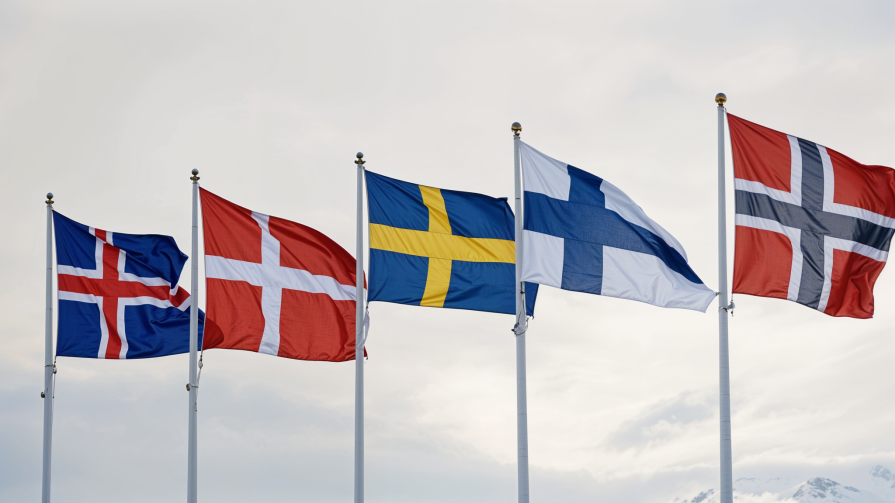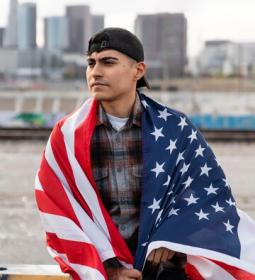Currently, the UN has 195 member states + two observers - the Vatican and Palestine (until 2002 such a state was also the Swiss Confederation). However, in addition to universally recognized countries on the planet, there are several dozen partially recognized – such as Kosovo, Abkhazia or the Sahrawi Arab Democratic Republic with Taiwan – or even completely unrecognized such as Transnistria, Somaliland, Puntuland or Nagorno-Karabakh. As well as numerous autonomies, also almost having sovereignty. At the beginning of 2021, there are more than 260 of them.
Each of these entities has state attributes: the armed forces, territory, governing bodies, symbols - anthem, coat of arms and flag. The subject of our material is just the latter. Today we will talk about the flags of the Scandinavian states.
It is no secret that there are several "model" flags in the world, which served as a prototype for dozens and hundreds of others. The Russian flag was generated by the Dutch, on which the colored stripes were swapped, and, in turn, gave rise to dozens of flags of Slavic states - from Bulgaria to Yugoslav countries and even Poland (minus the blue stripe, its flag also repeats the Russian).
In the Scandinavians, the role of the flag is played by a cloth with a cross shifted to the left. Of course, the cross symbolizes Christian values. Initially, its appearance on the Scandinavian flag was the will of the Danish king, who placed such a cross on his cloth and caftans of the soldiers of the personal guard. This happened on June 16, 1219 before the Battle of Lindanis - then the Danish king Valdemar II near the current location of the Estonian capital defeated the combined army of Livonians and Estonians, seized land and founded the Duchy of Estonia here.
Being documented, this fact got into the Guinness Book of Records - the Danish flag, nicknamed the Danneg,is recognized as the oldest of the existing national flags.
Such a cross slowly spread to the rest of the Scandinavian countries. Let's talk briefly about each.
Norway

Joining the scandinavian flag family is due to the ancient political alliance between the two kingdoms of Denmark and Norway; during this period, Norwegian sailors used Danish colours. This continued until 1814, when the Norwegian kingdom replaced the senior partner - the place of the Danes was taken by the Swedes.
The flag was modernized, based on new realities - in 1821 the Dannebrog received a dark blue cross with a white border, which symbolized freedom from Danish rule and echoed, on the one hand, the flag of revolutionary France (note that the Swedish king was Napoleonic General Bernadotte), and on the other - to thirteen former colonies that gained independence during the merciless war against the former metropolis.
When at the beginning of the XX century Norway finally gained full independence, the flag remained unchanged - the proud country of fjords got used to it.
Sweden
The date of appearance of the Swedish flag in its current form is unknown, but the earliest specimens depicting the yellow cross on a blue background as one of the military banners date back to the XVI century, around the same time pennants with a cross appeared on the masts of the royal koggs and augers that accompanied the Hanseatic convoys to Visby.
There is a myth according to which for the first time such a flag appeared in 1157. The Swedish ruler Eric IX proclaimed the first crusade to peaceful and unsuspecting Finland. Before he began to cut out the pagans, as befits a Catholic king, His Majesty prayed and, they say, saw a sign above his head: a golden cross in the blue sky. Of course, the Finns had no chance after such and such arrivals.

Although the myth is beautiful, and helps to remember the flag of the country of the victorious Eurosocialism, but there is no historical basis under it - as well as reasons to believe that it was an imitation of the danube.
Iceland
If Norway received the flag and independence almost simultaneously, then little Iceland, known throughout the world as the mayor of the pirate party, hot springs and a volcano with an unpronounceable name, received the flag as a result of the occupation. Or rather, two.
First, the Germans in 1940 captured Denmark, and then the Americans, under the pretext of capturing by German sailors and turning into an outpost of Nazi aggression, occupied Iceland. Away from sin. In 1944, they looked around, realized that occupation was not foreseen, and gave the Icelanders independence, and at the same time the flag.
Despite the similarity with other Scandinavian flowers, the nature here is completely different, the colors are associated with the views and relief of the country. Blue symbolizes the waters of the Atlantic, white - glaciers and snow, and red - the flame of magma, bursting out of the earth. However, red reminds of danish influence, and blue and white go back to the colors of the legendary Order of the Silver Falcon.
Finland
The Finns have three official symbols – the national, national flags and the standard of the President of the Republic.
National - blue crosser,as it is called by patriots - a descendant of the Nyland Maritime Club, which was created in 1861 under the protectorate of the Finnish governor, the younger cousin of the ruling Alexander II, Grand Duke Constantine, a great fan of the navy and seafaring affairs.

According to belief, the blue cross is dedicated to the sky and lakes, of which there are more than 10 thousand, and the white cross is dedicated to snow and ice. The cross, of course, to the Lord. The state differs from the national by the inclusion of the coat of arms in the middle of the cross. This is placed on state residences and hung on holidays. And the presidential one is equipped with three triangles on the right side and a yellow-blue cross of the Order of Liberty in the kryzh.
The Scandinavian cross is also present on the flags of the Shetland and Orkney archipelagos, which for a long time belonged first to the Danes during the Danish law, and then to the king of Norway (now the property of the United Kingdom of Great Britain and Northern Ireland), the Åland Islands - the Finnish autonomous territory in the Baltic Sea.
Red and blue crosses on a white background rinse in the wind over the Faroe Islands, and red and yellow on red with two English leopards - over the flag of the Norman commune of Falaise in France (it was once owned by a noble Norman robber).
In the past, the Scandinavian cross was also popular: it served (in black and white) as a banner for the Teutonic Order, the Saar Protectorate during the Interbellum period, as well as the Grand Duchy of Oldernburg and the United Baltic Puppet of the German Emperor in the occupied lands in 1917.









